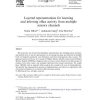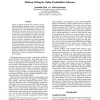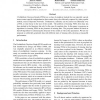215 search results - page 13 / 43 » Coarse-to-Fine Inference and Learning for First-Order Probab... |
CVIU
2004
13 years 7 months ago
2004
We present the use of layered probabilistic representations for modeling human activities, and describe how we use the representation to do sensing, learning, and inference at mul...
ICCV
2001
IEEE
14 years 9 months ago
2001
IEEE
Tree-structured probabilistic models admit simple, fast inference. However, they are not well suited to phenomena such as occlusion, where multiple components of an object may dis...
ECML
2007
Springer
13 years 11 months ago
2007
Springer
Most traffic management and optimization tasks, such as accident detection or optimal vehicle routing, require an ability to adequately model, reason about and predict irregular an...
AAAI
2010
13 years 9 months ago
2010
Lifting can greatly reduce the cost of inference on firstorder probabilistic graphical models, but constructing the lifted network can itself be quite costly. In online applicatio...
IJAR
2010
13 years 6 months ago
2010
Probabilistic Decision Graphs (PDGs) are a class of graphical models that can naturally encode some context specific independencies that cannot always be efficiently captured by...



